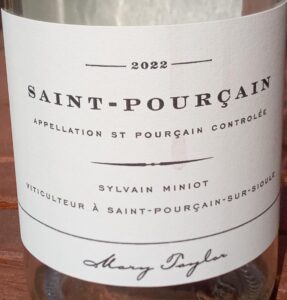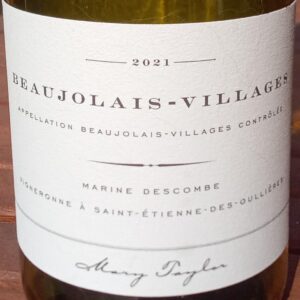“These are two decidedly different expressions of Gamay, and each
represents the variety beautifully in its own particular manner.”
I don’t get over to Ann Arbor as much as I used to, but when I found out that Mary Taylor would be at Plum Market’s North Campus location this past Thursday, I made a point of being there too. I only just discovered Mary Taylor Wines in February, but I’ve enjoyed everything I’ve tried so far, and here was an opportunity to sample new things that I haven’t had access to previously.
Even better, I had the chance to meet and spend a little time talking with Mary, who is every bit as straightforward and down-to-earth as the wines she imports. She’s had to work her ass off to compete successfully in an industry dominated by men, and now that she’s living her proverbial dream, we’re all better off for it.
There were ten wines available to taste and purchase, two of which (the Bordeaux Blanc and Costières de Nimes) I’ve already reviewed, so I focused on the eight that were new to me. Once again, I enjoyed everything I tasted, but I brought home the six I like most for further consideration, starting with another entry in one of my favorite categories, dry rosé.
2022 Mary Taylor Wines Sylvain Miniot Saint-Pourçain Rosé, 12% alc., $13.99: My first quick snapshot impression of this pale pink from the Loire Valley reads, “Bone dry and mineral-driven, with good intensity.” A second, more leisurely sample reinforces that note, fleshing out to include wet stone, rain water, strawberry and watermelon flavors on a medium-bodied frame. The acids are balanced, the finish lingers nicely and every sip reminds me again why I enjoyed this so much when I first tried it. 100% Gamay, aged 5 months on its lees in stainless steel tanks. Find this wine
The Loire Valley appellation of Saint-Pourçain is nestled in Auvergne, one of France’s oldest wine regions. Founded in Roman times and developed by Benedictine monks in the Middle Ages, Saint-Pourçain appeared in the first “Concours des vins de France” in the 14th century and enjoyed a privileged status in the Bourbon royal court.
Officially classified as a Vin de Qualité Supérieure in 1951, Saint-Pourçain was upgraded to full AOC status in 2009. AOC Saint-Pourçain is made up of 19 communes spread over some 600 hectares centered around the small town of Saint-Pourçain-sur-Sioule in central France. The Sioule River is a tributary of the Allier River which in turn is a tributary of the Loire. This points to the uniqueness of Saint-Pourçain, which although technically is part of the Loire Valley, is as close to Burgundy or the Rhône Valley as it is to the Loire.
2021 Mary Taylor Wines Marine Descombe Beaujolais-Villages, 13% alc., $17.99: This is not your hipsters’ Bojo, nor is it another bubble gum and banana mess. It shows good dark color, and some earthy cranberry on the nose, but really gets a little deeper and darker on the palate. It’s obviously Gamay, with some of that floral quality that so distinguishes the variety, but it’s unlike so much of what passes for Beaujolais-Villages around these parts these days. The medium-full bodied wine’s earth, cranberry and black cherry characteristics are seamless and complete. This has the structure to cellar for at least a few years, and may even improve with a little age, but I like the way it drinks right now, and, of course, it gets better as it opens with air. This would pair nicely with anything from a thinly-sliced medium rare flank steak on a bed of Kim’s super green salad to some delectable grilled pork loin. 100% Gamay, from 55 year-old vines. Find this wine
A textbook blue stone Brouilly-style Beaujolais-Villages from one of the great women winemakers in France. Winemaking : Manual harvest with a strict selection. Partial destemming (40%). Burgundy-style vinification. Vatting: 10 days. Grapes are pressed softly and slowly. Fermentation: 1 month. Aging in tanks: 6 months.
Beaujolais-Villages is … the first appellation in France to use the term “villages.” In 38 municipalities of the Rhône and Saône-et-Loire, and 3 geographical zones with marked specificities, these fruity and fleshy wines reflect the characteristics of their terroirs. The vines are often planted at altitude and on hillsides. These delectable red wines mark a kind of transition between Beaujolais, in the south, and the ten crus further north.
These are two decidedly different expressions of Gamay, and each represents the variety beautifully in its own particular manner. Both exemplify Mary Taylor’s mission to import “the kind of honest, authentic wines that the Europeans have been enjoying for centuries.”
I would be remiss in not mentioning Plum’s great staff of wine experts, headed up by the incomparably Master Sommelier Madeline Triffon, the first American woman, and only the second woman in the world to pass the Master Sommelier Exam (MSE). I hadn’t had the chance to rub elbows with her or any of her top-notch crew (Jorge Luis Lopez-Chavez, Mike Fifer, Marshall Wehr and Rod Johnson) since before the pandemic, so I was especially pleased to renew acquaintances with them all.
In my next entry, I will focus on the other two French wines I brought home from the tasting, from Cabrerisse and Cahors respectively. In the meantime, I might suggest that the reader browse through the Mary Taylor Wines website. It’s chock full of information about all of the wines, the regions from which they originate and the artisans who are responsible for making them.
Mary Taylor Wines are imported by Nashawtuc LLC, Sandy Hook, CT
Reporting from Day-twah,
Bastardo





Pingback: More from Mary Taylor Part 2 | Tasting Notes from the Underground
Pingback: More from Mary Taylor Part 3 | Tasting Notes from the Underground